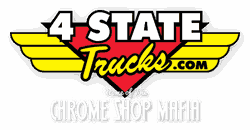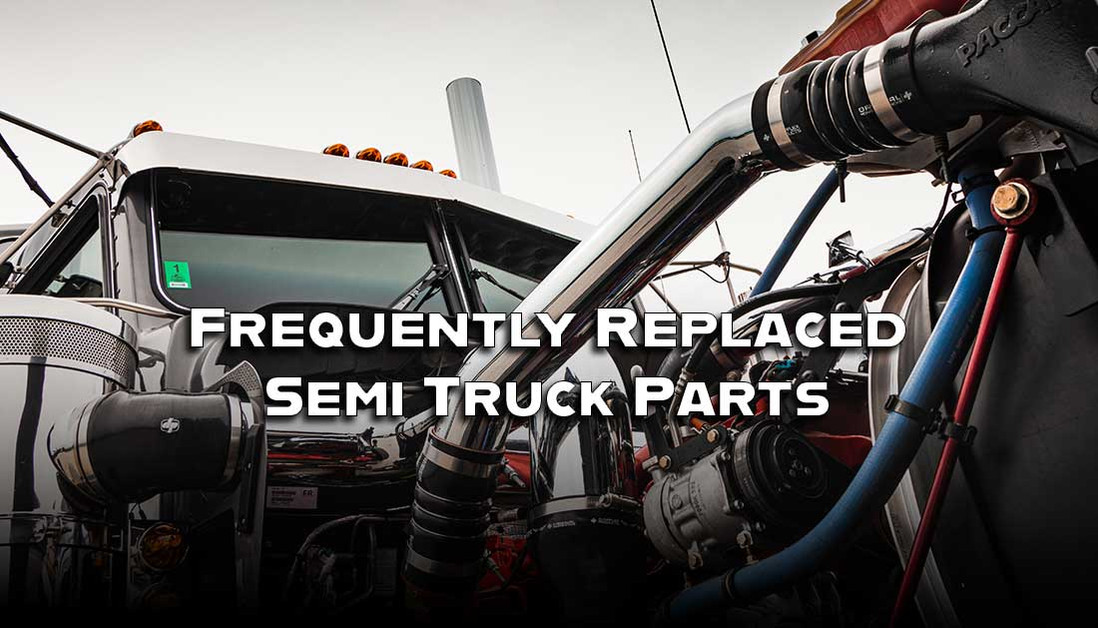What are the Most Frequently Replaced Semi Truck Parts?
The parts of a class 8 truck that see the most frequent repair and replacement are areas where tons of heat, friction, and pressure occur. No brainer, right?
Here are some of the most frequently replaced semi truck parts, along with some tips on how to find reliable aftermarket replacement semi truck parts for your truck’s model and year.
Be sure to adhere to commercial truck maintenance best practices to avoid costly replacement.
Brake Components
Without proper brake maintenance, those brakes will fail you sooner. When they do, a replacement part will be needed.
The most commonly replaced brake parts are the ones that directly experience the most friction and heat from the act of braking.
Brake Pads:
- The brake pads create friction against the rotors/drums which inevitably wears it down.
Brake Drums:
-
Newer models have air disc brakes, but for most older models, the brake pads experience enormous friction and heat from hard braking and high-speeds.
Rotors (Disc Brakes):
-
Regular breaking over long periods of time will generate intense heat which warps or cracks the rotors, requiring a replacement.
Brake Shoes:
-
A component of the drum brake system that acts like a brake pad. These can wear down and require replacement with frequent, aggressive braking.
As a good driving habit, avoid aggressive braking and perform regular inspections on brake components.
Measure the stroke and check the brakes. Hire a pro at a maintenance shop or do it yourself.
Tires
Pretty obvious, right? Tires see the most wear and tear on the road. That’s why it’s important to get quality tires if it’s the last thing you do. Over 50% of on-the-road breakdowns are due to worn-out tires.
- Misaligned axles (the tires aren’t touching the road evenly and wear down quickly).
- Overinflated tires wear out the center line of the tire and it doesn’t have proper tread.
- Underinflated tires wear the outside walls of the tire.
You can maintain your tires with aftermarket tire kits.
Tire alignments can save you thousands of dollars on tire replacements. You can use your tire tread down to the legal limit until replacement to get the most for your money.
Cheap knock off tires aren’t a good investment. You’ll replace them too quickly - which is really expensive.
Engine Parts
Engines are complex. They have so many internal parts and they’re bound to break at some point during your many years of long-hauling.
Signs there’s something wrong with your engine: shaking, clicking, and clacking sounds.
Air Compressors
They supply compressed air to the truck’s brake system, air suspension, and other components. Because they operate under high pressure, frequently cycling on and off, they generate heat and stress.
Replace every 5-10 years.
Fan Blades
Fan blades keep the engine cool by circulating air through the radiator. Over time, they can simply get worn down.
Fuel Filters
Fuel filters remove contaminants from the fuel which prevents damage to the injectors and engine.
Batteries
Batteries get worn down due to a frequent start-stop cycle, which drains the battery over time. The battery has to exert a lot of energy to maintain accessories like refrigeration units, GPS systems, and other in-cab electronics accessories. When the engine is off, in-cab items draw battery life.
Here are the components that you'll need to replace, aside from the battery itself:
Battery cables and terminals: corroded or frayed cables interrupt power flow and stop proper charging of the battery
Starter motor: a weak battery strains the starter, causing it to wear out prematurely.
Alternator: essentially, a type of electric generator to charge your semi truck’s battery and electrical system. But these tend to go bad frequently.
They’re made in bulk at a manufacturing plant and there can be defects.
Signs of a bad alternator: burning smell, dead battery, warning light, dimming lights, growling noises, and frequent stalling.
Electrical Systems
Semi trucks have endless amounts of electrical wires.
Each wire connects to something to perform a function. If a wire isn’t secure, the vibrations of a truck on the road can loosen and run through.
Now, you’re looking at replacing a component. Just replacing a $50 wire can save you thousands of dollars worth of future replacement components.
Check the connections on your truck on any wire mount you see. Do it daily.
Shock Absorbers
Shocks bear the weight of heavy loads and internal components which can naturally wear down over time.
Replacement interval: 150,000-250,000 miles on average.
Suspension Components
- Springs: (leaf or air springs) absorb the shocks and vibrations of the road
- Bushings: flexible cushions between the frame, spring, and axles to absorb friction
- U-bolts: fasteners that secure the springs to the axle
Exhaust System Components
High heat and road vibrations can wear down your system over time, leading to leaks, cracks, or clogged diesel particulate filters.
Diesel Particulate Filter (DPF) traps and removes particulates from the diesel exhaust.
A DPF can get cracked and clogged, which leads to inefficient fuel consumption. It then needs to be replaced.
How to prevent it?
Inspect the exhaust components regularly and clean out your DPFs as needed.
Coolant and Radiator Components
Radiators can become clogged and corroded with time. Coolants also degrade over time. You should aim for a coolant flush every 100,000 miles.
Radiator components should be swapped out based on their condition. The most frequently replaced radiator components include:
Radiator hoses: high-temperatures, pressure, and coolant flow can degrade the rubber material
Signs of damage: coolant leaks, brittle texture, cracks or bulges.
Replace the hose every 50,000 - 100,000 miles.
Radiator core: inadequate coolant maintenance leads to wear and tear and sediment buildup over time.
Replace the core every 5 - 10 years, as needed.
Radiator cap: the spring mechanism can wear out and cause pressure loss or a degraded rubber seal can add to leaks.
Replace every 2-3 years when and if it starts to fail.
Thermostat: gets stuck open or closed due to high heat and pressure buildup over time; signs of damage include overheating, underheating, or massive temp fluctuations.
Replace this part every 50,000 - 100.000 miles.
Fan clutch: Mechanical fan clutches wear out and burn out from high use or road debris, damaging the fan blades, leading to reduced airflow through the radiator.
Replace every 100,000 - 150,000 miles.
Coolant reservoir: cracks or leaks occur from overuse or aging and can appear as leaks near the reservoir and surprisingly low coolant levels.
Replace after every 5-7 years.
Radiator drain plug: the threads or seals can degrade and then leak coolant.
Find Aftermarket Replacement Parts at 4 State Trucks
Need help finding the right replacement part for your rig? Give us a call today and one of our specialists on staff will be happy to help!
Recent Posts
-
5 Unique Lug Nut Cover Styles to Give Your Truck a More Polished Look
Semi truck lug nut covers aren’t just useful in protecting your lug nut and wheel studs, …14th Apr 2025 -
Top 4 Semi Truck Power Inverters to Fully Charge Your Appliances
Semi truck power inverters are critical for truckers who need more comfort, productivity, safet …31st Mar 2025 -
Top Semi Trucks Owned in Each State (Data for All 50 States)
Here's some visual data on the most commonly owned heavy duty semi truck models based upon four top …26th Mar 2025 -
Best Sleeper Cab Upgrades for Comfortable Long-Haul Trucking
A comfortable sleeper cabin space can improve your rest, well-being, and productivity on the road. I …14th Mar 2025 -
How to Customize Your Peterbilt 379 with Aftermarket Parts (Within a Budget)
The Peterbilt 379 truck is an iconic, bold, and rugged-looking classic, beloved among owner-operator …13th Mar 2025 -
Peterbilt 379 Short Hoods vs Long Hoods
Your Peterbilt 379 hood is more than metal—it’s a statement. If you’re comparing p …12th Mar 2025 -
Are Semi Truck Grille Guards Worth the Money?
Ever seen another truck driver barreling down the highway with a 14-gauge stainless steel or chrome …7th Mar 2025 -
What are the Best West Coast Mirror Styles for Semi Trucks?
The West Coast mirror has been a staple of commercial trucks since trucking started. Constructed for …6th Mar 2025 -
Top 5 Mudflaps to Consider in 2025
Mud flaps are essential for truckers to stay DOT-compliant on the road and protect other vehicles fr …4th Mar 2025 -
Top 5 Peterbilt Step Tool Boxes to Maximize Style and Storage
If you’re looking for semi truck tool boxes that make the absolute most utility out of your ri …3rd Mar 2025














